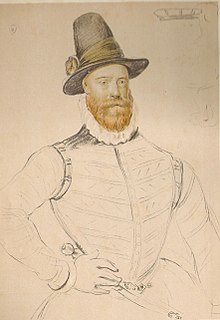Related Research Articles

James Douglas,4th Earl of Morton was the last of the four regents of Scotland during the minority of King James VI. He was in some ways the most successful of the four, since he won the civil war that had been dragging on with the supporters of the exiled Mary, Queen of Scots. However, he came to an unfortunate end, executed by means of the Maiden, a predecessor of the guillotine.
John Stewart, 4th Earl of Atholl was a Scottish noble. He was favoured by Mary, Queen of Scots, but later turned against her.
John Colville, Scottish clergyman, judge, politician and author, was the son of Robert Colville of Cleish, in Kinross.
The Raid of Ruthven was a political conspiracy in Scotland which took place on 22 August 1582. It was composed of several Presbyterian nobles, led by William Ruthven, 1st Earl of Gowrie, who abducted King James VI of Scotland. The nobles intended to reform the government of Scotland and limit the influence of French and pro-Catholic policy, and to prevent or manage the return of Mary, Queen of Scots from England. Their short-lived rule is known as the "Ruthven" or "Gowrie Regime".

Sir William Kirkcaldy of Grange was a Scottish politician and soldier who fought for the Scottish Reformation but ended his career holding Edinburgh castle on behalf of Mary, Queen of Scots and was hanged at the conclusion of a long siege.
Sir John Bellenden of Auchnole and Broughton was, before 1544, Director of Chancery, and was appointed Lord Justice Clerk on 25 June 1547, succeeding his father Thomas Bellenden of Auchnoule. John was knighted before April 1544.
Lady Margaret Erskine was a mistress of King James V of Scotland and mother of Regent Moray.
James Colville, 1st Lord Colville of Culross (1551–1629) was a Scottish soldier, courtier, and diplomat.
Sir William Stewart of Houston was a Scottish soldier, politician and diplomat.
Robert Sempill, 3rd Lord Sempill was a Scottish lord of Parliament.

The Marian civil war in Scotland (1568–1573) was a period of conflict which followed the abdication of Mary, Queen of Scots, and her escape from Lochleven Castle in May 1568. Those who ruled in the name of her infant son James VI fought against the supporters of the Queen, who was exiled in England. Edinburgh Castle, which was garrisoned in her name, became the focus of the conflict and surrendered only after an English intervention in May 1573. The conflict in 1570 was called an "intestine war in the bowels of this commonwealth", and the period was called soon after an "intestine war driven by questions against authority."
Adam Gordon of Auchindoun (1545–1580) was a Scottish knight, younger brother of the Earl of Huntly and military leader during the Marian civil war on behalf of Mary, Queen of Scots in north west Scotland. In Scottish ballad lore, Adam became known as Edom o'Gordon.
Patrick Lindsay, 6th Lord Lindsay of the Byres, (1521–1589), Scottish courtier and Confederate lord.

Cornelius de Vos or de Vois or Devosse, was a Dutch or Flemish mine entrepreneur and mineral prospector working in England and Scotland, and said to be a "picture-maker" or portrait artist. De Vos is known for gold mining in Scotland.

Robert Gourlay or Robin Gourlaw was a wealthy Edinburgh merchant and Customar of Edinburgh who built a renowned house in Edinburgh.
Bedrule Castle is a ruined 13th-century castle in the Rule Valley, in the Scottish Borders area of Scotland.
Margaret Fleming, Countess of Atholl (1536-1586) was a Scottish courtier and landowner rumoured to be involved in the occult. She served as lady-in-waiting to Mary, Queen of Scots.
Nicolas Errington was an English soldier, military engineer, and administrator.
Michael Gilbert was an Edinburgh goldsmith and financier.
Adam Erskine, Commendator of Cambuskenneth, was a Scottish landowner and courtier.
References
- ↑ David Laing ed, Original letters of Mr. John Colville, 1582–1603 (Bannatyne Club, 1858).
- ↑ David Laing ed, Original letters of Mr. John Colville, 1582–1603 (Bannatyne Club, 1858), p. xiii.
- ↑ Thomas Thomson, Diurnal of Occurrents (Edinburgh, 1833), p. 158.
- ↑ William Boyd, Calendar State Papers Scotland: 1569-1571, vol. 3 (Edinburgh, 1903), pp. 156-7 no. 214.
- ↑ William Boyd, Calendar State Papers Scotland: 1571-1574, vol. 4 (Edinburgh, 1905), p. 130.
- ↑ William Boyd, Calendar State Papers Scotland: 1571-1574, vol. 4 (Edinburgh, 1905), p. 289.
- ↑ William Boyd, Calendar State Papers Scotland: 1571-1574, vol. 4 (Edinburgh, 1905), p. 313.
- ↑ Charles Thorpe McInnes & Athol Murray, Accounts of the Treasurer: 1574-1580, vol. 13 (Edinburgh, 1978), pp. ix, xi.
- ↑ Gordon Donaldson, Register of the Privy Seal: 1567-1574, vol. 6 (Edinburgh, 1963), p. 413 no. 2182.
- ↑ Charles Thorpe McInnes & Athol Murray, Accounts of the Treasurer: 1574-1580, vol. 13 (Edinburgh, 1978), p. 215.
- ↑ William Boyd, Calendar State Papers Scotland: 1581-1583, vol. 6 (Edinburgh, 1910), pp. 541, 565, 621.
- ↑ Gordon Donaldson, Register of the Privy Seal, vol. 7 (Edinburgh, 1966), nos. 1229, 1928, 2027, 2051, 2376.
- ↑ Pamela Giles, 'Lindsay, Christian', Elizabeth Ewan, Siân Reynolds, Rose Pipes, Jane Rendall, New Biographical Dictionary of Scottish Women (Edinburgh, 2018), p. 27.
- ↑ Peter Anderson, Peter, Stewart Earls of Orkney (Edinburgh, 2012), p. 163.
- ↑ David Masson, Register of the Privy Council of Scotland, vol. 12 (Edinburgh, 1895), p. 472.